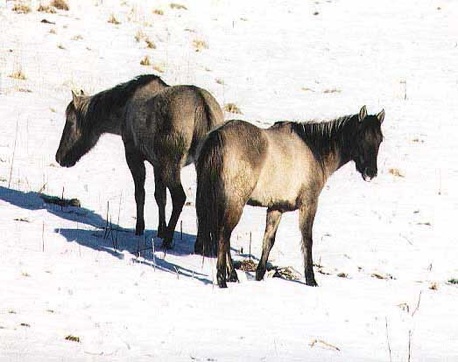THE SORRAIA MUSTANG – GENERAL INFORMATION
Spanish mustangs are feral horses of Spanish descent, tracing back to the horses of the Spanish conquistadors, and in some cases, to Portuguese horses. The most primitive and original of them are of Sorraia type. Sorraia Horses are a remnant population of an indigenous, South Iberian wild horse, which survived in the inaccessible lowlands of the Portuguese river Sorraia until the early 1900s - not pure, but retained enough of the original characteristics to have kept its identity. The Iberian scientist and horse expert Dr. Ruy d’Andrade discovered these horses in 1920 and is responsible for their preservation.
German hippologist Hardy Oelke discovered years ago that the Sorraia also lives on in certain strains of Spanish mustangs in America, as well as in South American criollos, and proved this through mitochondrial DNA sequencing. The mtDNA analyses, done by a German institute for molecularbiological research, showed that the amazing similaritiy of some mustangs and the Sorraia horse isn’t incidental, and proved a genetical relatedness.
Evidence suggests that Columbus may have already shipped Sorraias to the New World. More information on this is available in the book "Born Survivors on the Eve of Extinction“ resp. the German edition "Das Vermächtnis des Columbus“.
Sorraia mare and mustang mare of Sorraia type – which is which?
Sorraia-type mustangs have been found in several Herd Management Areas (HMA) of the Bureau of Land Management (BLM) and also among horses bred within "mustang" registries like the SMR and SSMA. These registries register horses that trace back to mustang ancestors, but have been bred under domestic conditions for generations. Technically, the only difference between a mustang and a domestic horse is that the mustang lives wild, therefore, as soon as such a horse is back under domestic conditions, it stopped being a mustang. The "mustang" registries aim at preserving the qualities of the mustang, however, that is only possible under wild or nearly wild conditions.
The BLM herds that have produced the most Spanish Mustangs and Sorraia Mustangs are the Kiger herd in Southeast Oregon and the Sulphur Springs herd in western Utah. Sorraia-type mustangs were also found in some other herds, like the Pryor Mountain herd on the Montana/Wyoming state line and some Nevada herds.
The Sorraia Mustang Studbook was established to keep records of Sorraia Mustangs and to promote their pure breeding and preservation, in order to safeguard the Sorraia genes in the mustangs, and to rehabilitate the Sorraia-type mustang. By breeding Sorraia-type mustang to Sorraia-type mustang, the genetic makeup can be reinforced in favor of the Sorraia genes, and at the expense of non-Sorraia genes, thus not just preserving what was left of the Sorraia genes in the mustang population, but improve on it and eventually accomplish near purity.
To register a horse, send in name, date of birth, heigth, HMA it was captured in, as well as photographs that clearly show the horse’s conformation and color, including a close-up of its head profile and front leg stripes. In the case of a horse already registered in one of the Spanish mustang registries, include its registered name and pedigree information.
If you are interested in the Spanish mustang and the Sorraia-type mustang and its preservation, you may write to:
You will also find the most complete information about Sorraia horses at:

